Pros
Cons
Introduction
Front
{{section_header}}{{section.name}}{{/section_header}}

Back
{{section_header}}{{section.name}}{{/section_header}}

Sides
{{section_header}}{{section.name}}{{/section_header}}

Top
{{section_header}}{{section.name}}{{/section_header}}

Bottom
{{section_header}}{{section.name}}{{/section_header}}

In the Box
{{section_header}}{{section.name}}{{/section_header}}

- The Camera
- Wrist Strap
- 'Paint pen' for operating touch screen
- NP-BN1 battery
- Battery charger
- Combination A/V & USB cable
- Software CD (not shown)
- Manual (not shown)
No Memory Stick card is included as part of the standard package, and we did not receive a printed manual. However, Sony tells us that retail boxes will come with a printed manual, and we reviewed a PDF version.
Color
{{section_header}}{{section.name}}{{/section_header}}
In our tests on how accurately the TX5 captured colors, we found that it did an excellent job, capturing colors that were very close to the originals in our test chart. We test this by photographing a color chart under tightly controlled conditions, then using Imatest to analyze how closely the colors match the original in the chart. The only areas where we found a minor issue was with some of the yellows and blues on the chart, which came out a little oversaturated, producing colors that were a little bright. But this was a minor issue, and the color was generally very good. More on how we test color.
Color Modes
{{section_header}}{{section.name}}{{/section_header}}
Many cameras offer multiple color modes which allow you to tweak the color as it is captured. The TX5 does not; it leaves all color processing until after the image is captured.
Noise
{{section_header}}{{section.name}}{{/section_header}}
Noise is the curse of digital photography. Caused by random glitches in the image sensor, it shows up as a staticky pattern on images, especially those shot with the ISO cranked up. Although there is noise on the images captured by the TX5, we found that the amount of noise was generally a lot lower than other cameras, with images having a cleaner, smoother look. Sony says that their new Exmor R sensor has lower noise than others, and that certainly seems to be true in our tests. More on how we test noise.
We test the amount of noise at different ISO levels for two situations: shooting in a brightly lit room (3000 Lux) and a dimly lit room (60 lux). We do this because many cameras treat these two situations differently, introducing noise removal or other processing that tries to remove the noise from the image. We found that the amount of noise didn't differ much in either situation, though; the noise remains mostly constant up to an ISO level of 800, but then climbs to just over 2 per cent at the maximum ISO level of 3200. There is a price to pay for this relatively low noise, though; the images have a fuzzy, almost soft-focus look that is because of the noise reduction processing that the camera does. For examples of what this noise processing looks like in real images, see below.
If we compare the noise to other cameras , you can see that the TX5 has lower noise than most (except for its less robust stablemate, the TX7), and that the noise remains lower across the ISO range. In particular, the noise at the higher ISO settings is much lower than the Panasonic DMC-ZS3.
{{comparison_bars title="Noise Score Comparison", attribute="Noise Score", xLabel="Noise Score"}}
ISO
{{section_header}}{{section.name}}{{/section_header}}
The TX5 has an ISO level that ranges from 125 right up to 3200, all at the full resolution of the camera. There is a scene mode that is described as 'High ISO', but this does not increase the maximum resolution: it just sets the camera to use a higher ISO setting than the standard auto mode.
NOTE: The images above are not used in our testing or scoring, but are included here to show real-world examples of the differences between cameras at the various ISO settings.
Resolution
{{section_header}}{{section.name}}{{/section_header}}
We were also favorably impressed with the performance of the TX5 in our tests on the resolution of the images it captures. We found that the images were sharp and had only slight distortion across the 4x zoom range that this camera can manage. The only issue that we saw was a small amount of chromatic aberration in the middle of the zoom range. More on how we test resolution.
Distortion ({{product.raw_scores['Distortion Score']}})
We found that the images that this camera captured had very low distortion at the mid and telephoto points of the zoom range, with both showing less than 0.5 per cent distortion, which is pretty much invisible. There was a bit more at the widest point of the zoom range, though; we saw about 1.5 per cent distortion, which is just enough to be visible: long thin objects like lamp posts and walls will look slightly distorted. Below are examples of the distortion from our test chart.
Sharpness ({{product.raw_scores['Sharpness Score']}})
We found that the images captured by the TX5 were pretty sharp for the most part, although the sharpness did fall off somewhat at the edge of the frame in all of our test images, as you can see in the examples below. This slight drop in sharpness was present at all points on the zoom range, but was particularly pronounced at the wide and telephoto ends of the zoom range, where it became quite significant.
Chromatic Aberration ({{product.raw_scores['Chromatic Aberration Score']}})
The other thing that we noticed was that there was a significant amount of chromatic aberration (CA) at the widest end of the zoom range on the edges of the frame. The amount of CA that we saw at the mid and telephoto zoom points was low, but there was a lot at the widest zoom point, which shows in the wide crops on the charts below and our sample photos as a distinct color fringe to sharp edges.
Quality & Size Options
{{section_header}}{{section.name}}{{/section_header}}
The TX5 provides a range of image size options (see below), but there is no control over the amount of compression used on the image. There is also no support for saving RAW images, which contain the raw data from the image sensor.
Image Stabilization
{{section_header}}{{section.name}}{{/section_header}}
The TX5 has two forms of image stabilization: as well as an optical system that moves an element of the lens to compensate for movement, there is a special mode called Anti-Motion Blur. In this mode, the camera snaps 6 images with one shutter press, then processes and stacks them to create a single image. We found that this mode works very well, with images taken using it looking much sharper than those in other modes. There is a minor downside, though; the process of combining the images take several seconds, so you typically only get one attempt at a shot. But it's worth using if you are shooting in low light and your subject can sit still for a few seconds. More on how we test image stabilization.
Video Mode
{{section_header}}{{section.name}}{{/section_header}}
Although the TX5 is a compact camera, it has a long list of video features, including the ability to capture videos at 1280 by 720 resolution at 30 frames per second. That's the same resolution as a 720p HDTV, but only half of the 60 fps frame rate that these displays show. This camera doesn't follow the trend we have seen of cameras capturing video in AVCHD format, though: videos are saved as .MP4 files . Mono sound is captured by the small microphone just below the flash on the front of the camera, but there is no way to attach an external microphone.
An analog video output cable is included with the camera, but there is no HDMI cable included. An optional adapter is available that allows a HDMI cable to be connected, but this costs $60.
Video Color
{{section_header}}{{section.name}}{{/section_header}}
Although the TX5 captured good color in still images, the colors in videos were less appealing: colors in our captured test videos looked a little garish. They were not as bad as many of the cameras that we test, but this camera does not provide any way to tweak the colors for better accuracy. More on how we test video color.
{{comparison_bars title="Video Color Score Comparison", attribute="Video Color Score", xLabel="Video Color Score"}}
Video Sharpness
{{section_header}}{{section.name}}{{/section_header}}
We did find that the videos were pretty sharp, though; capturing video on the highest quality setting (AVCHD at 17Mbps) we saw a good amount of detail in the video, and motion was smooth. It is not as good as a dedicated camcorder (or as good as the video that many SLRs are now capturing), but it is definitely acceptable. More on how we test video sharpness.
{{comparison_bars title="Video Color Sharpness Comparison", attribute="Video Sharpness Score", xLabel="Video Sharpness Score"}}
Playback Mode
{{section_header}}{{section.name}}{{/section_header}}
The TX5 has a big, bright sharp screen, and it makes the most of this to playback images with a variety of slideshows and playback options. Slide shows can be easily created with a number of transition effects, and it comes with four types of music, as well as the ability to upload your own MP3s with the bundled 'Music Transfer' application. Images can sorted by date, and up to 28 thumbnails can be viewed on screen at once.
In-Camera Editing
{{section_header}}{{section.name}}{{/section_header}}
You get a decent selection of basic editing tools with the TX5: images can be cropped, resized, rotated and have red-eye removed. There is also a basic image editing program that allows you to draw onto images using the touch screen, but this is extremely primitive and is best avoided.
Direct Print Options
{{section_header}}{{section.name}}{{/section_header}}
Both DPOF and PictBridge support are offered on this camera, which allow images to be flagged for printing, or for a direct connection to a printer. This camera also supports TransferJet, a new short range wireless feature that allows images to be transferred quickly.
Viewfinder
{{section_header}}{{section.name}}{{/section_header}}
There is no viewfinder on this camera.
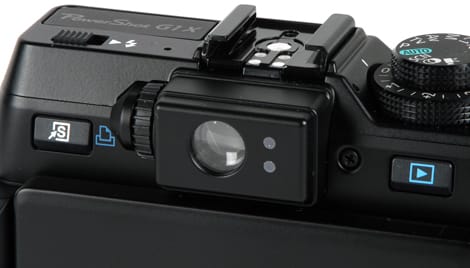

... and it has a diopter adjustment ring.
Display
{{section_header}}{{section.name}}{{/section_header}}
Dominating the back of the LCD is a 3-inch LCD screen with a resolution of 231k pixels. That is significantly less than the 921k of the TX5, and this makes images on the TX5 significantly grainier and less attractive. Presumably, the lower resolution is a consequence of the waterproof nature of the camera.
Although the LCD screen of the TX5 isn't as impressive as the TX7, it is certainly adequate for getting a decent preview of images before and after they are captured.

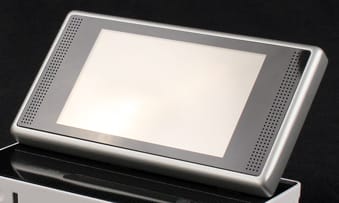
...but it turns into a nice 3-inch widescreen in playback mode.
Flash
{{section_header}}{{section.name}}{{/section_header}}
The flash of the TX5 is located to the left of the lens, on the front of the camera body. Like all small cameras, that places it rather close to the lens, which could result in red-eye. We didn't see too much of a problem here, though: images were mostly red-eye free, and a special editing tool is included to deal with then when they do occur.
A standard selection of flash modes are included, with options for full auto, off, forced on and a slow synch mode. There is no specific red-eye reduction mode, though and there is no flash exposure compensation.

The flash emitter pops up from the top of the body via a mechanical release.
Lens
{{section_header}}{{section.name}}{{/section_header}}
The lens of the TX5 is a 4x zoom that is completely within the camera body. A piece of glass on the front provides some level of protection for the lens, as well as waterproofing it. The aperture range of this lens is adequate, at f/3.5 to f/6.3.

Battery
{{section_header}}{{section.name}}{{/section_header}}
The TX5 is powered by a small NP-BN1 Lithium Ion battery that holds just 630 mAh of charge. Sony claims a battery life of around 250 images, or around 125 minutes. That feels about right to us; we found that it lasted for a couple of days of casual shooting, but no longer. A spare battery would be a wise precaution, and that will cost you $50.

Memory
{{section_header}}{{section.name}}{{/section_header}}
Like all of Sony's 2010 cameras, the TX5 comes with a memory card slot that can handle both Memory Stick Pro Duo and SDHC cards. This is a plus if you are upgrading from an older camera that uses SD Cards. A new 4GB Memory Stick Pro Duo card will cost you about $20.

Jacks, Ports & Plugs
{{section_header}}{{section.name}}{{/section_header}}
There is a single port on the TX5, located under a small cover next to the battery compartment. This multi-purpose port provides both the analog standard def A/V and USB connections of this device through a single included cable. That's rather unusual, as is the lack of HDMI support: there is no option to connect to a HDTV directly from this camera. Instead, Sony offers an adapter that allows this camera to connect to either a HDMI or analog component HDTV which, in typical Sony style, costs $60.
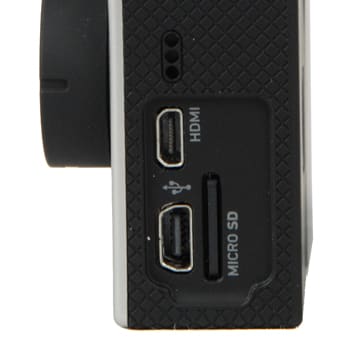
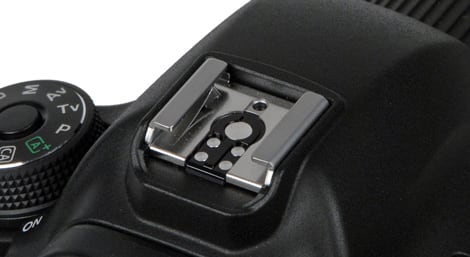
The cover of this port also feels rather flimsy: a slight bit of pressure in the wrong directions could snap it off, which would mean the camera is not waterproof anymore. So, this should be used with caution.
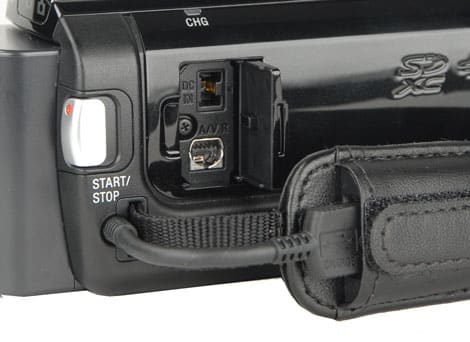
The DC-input and multi-AV port are located on the right side of the camcorder.
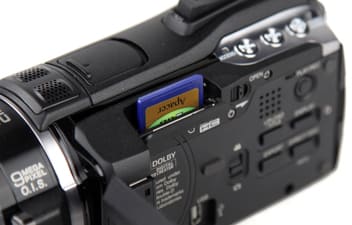
... as is the SD/SDHC card slot.
Other Hardware
{{section_header}}{{section.name}}{{/section_header}}
Waterproof
The TX5 is waterproof to a depth of 10 feet (3.3 meters), which means it can be used while snorkel diving or splashing around at the pool.
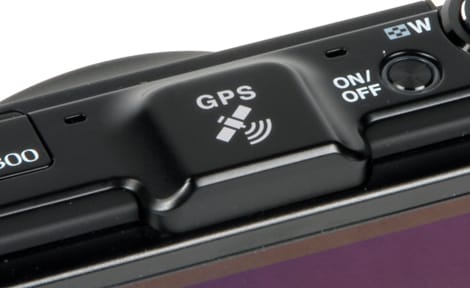
The new GPS module.
Drop-proof
The TX5 is built to withstand being dropped onto hard surfaces from heights of up to 5 feet (1.5 meters).
Cold-proof
The TX5 can keep taking photographs in temperatures of down to 14 degrees Fahrenheit (around -10 degrees Celsius), so it can be carried on the outside of a ski outfit for shooting.
Shooting Modes
{{section_header}}{{section.name}}{{/section_header}}
For real point & shoot use, the TX5 offers program mode, Intelligent Auto Adjustment mode or the Easy mode. As the names suggest, these offer varying amounts of user control; the program mode lets you configure most settings, while the Intelligent Auto Adjustment mode cuts down on the number of options that the user is presented with. The Easy mode puts everything into automatic; the only thing the user has control over is the image size, if the flash is in auto mode or is off and the self timer. This is obviously designed for the novice or nervous shooter, and it works well, simplifying the process of shooting and increasing the font size for those who may have difficulty reading the small on-screen text.
One thing that is missing from this camera is any sort of manual control: there is no way to set the shutter speed or aperture directly on this camera.
Auto Mode Features
Focus - We found the auto focus of the TX5 to be generally speedy in both normal light and low light. It usually took less than a second to find the right focus point, and was often much quicker. There are also a number of ways to control the focusing, including a neat feature where you tap on the touch screen to select the focus point. This is useful if you are trying to take a photo with the subject off-center. You can also set the camera to either automatically use 9 focus points, or to the center of the screen as the focus point, looking either at a small area or a single point in the middle.
Face detection is also available, with the camera being able to recognize up to 8 faces in the frame. You can either select the face to use as the focus point by tapping on it, or set the camera to prioritize on adult or child faces.
Exposure - A limited amount of control over how the camera exposes is available: in program mode, you can apply up to 2 stops of exposure compensation, in one third of a stop steps. This control (which Sony calls EV) is a little buried, though; you have to go into the main menu and select it, then set the level of compensation with a draggable scale on the screen. This camera does not support auto exposure bracketing: there is no way to get it to take a series of exposures at different levels automatically.
Metering - The usual metering mode options are available in program mode: there is an automatic evaluative mode (called multi), center weighted and spot metering. Enabling face detection also sets the camera to meter correctly for the faces in the image.
Aperture - The TX5 has a decent aperture range for a compact point & shoot; it has a range of f/3.5 to f/6.3 at all zoom settings.
Shutter Speed - The shutter speed range of the TX5 is also decent: it can go from a 1 second exposure down to 1/1600 of a second. Night owls might miss the longer shutter speeds that some cameras offer, but that's a wide enough range for a general use camera, especially when there is no manual mode that gives you direct control over the shutter speed.
Self Timer - As well as the usual options of a 2 or 10 second delay, the TX7 also uses its face detection as a self timer. It can hold on taking the photo until it detects either one or two faces in the frame for self portrait or couple shots. There is also a smile detect feature that can be used to take a smiling self portrait by holding off from taking the photo until it detects a smile.

The full mode dial is nice, but frequently rotates by accident.
Scene Modes
A wide selection of scene modes are also on offer: 12 in total. These include options such as Twilight, Gourmet, Pet and hi-speed shutter. In addition to these, the TX5 offers 4 special shooting modes:
iSweep Panorama - This mode allows you to take panoramic shots with a single sweep of the camera: you press the shutter, sweep the camera around in the indicated direction, and it takes a series of photos and stitches them together to form the panorama. These can be either vertical or horizontal panoramas, and we were impressed with the quality of the results: the camera did a good job of producing smooth, clean panoramas with little evidence of clipping or where the frames are blended together. This mode pioneered with the DSC-HX1 that was launched last year, but Sony claims to have improved it since then. It still needs to be used carefully, though, as objects can get chopped up. If you look closely at the buoy on the right of this panorama, you can see that it appears to get transparent, because of the movement of the buoy in the choppy San Francisco bay. You can see the full version of this file in our sample photos section.

Anti Motion Blur - In this mode, the camera takes 6 shots in quick succession, then amalgamates the shots to produce the sharpest image. The results are processed to make the image as sharp as possible. We found this to be fairly effective in reducing blur; in the photos below, the one at the top was taken in program mode, and the bottom one in Anti-Motion Blur mode. The right one is much sharper because the camera detected the motion of the car and used the multiple frames it captured to produce a sharper image. It isn't perfect, though; the car is still rather blurry.


Hand-Held Twilight - Shooting in the evening hour can be tricky: low light means that you have to use a longer shutter speed, which means a blurry image. This mode tries to get around this by quickly taking 6 photos, then combining the images to form the final one, discarding any images that are blurry. We found that this produced very attractive results, producing sharper images with more dynamic range than images taken in the standard night scene mode.
Backlight Correction HDR - This mode uses HDR (High Dynamic Range) processing, where the camera combines two images taken at different exposure settings to increase the dynamic range of the camera, so shadow details are more visible. The camera takes one photo metering for the background and another metering for the subject, then combines the two to try and capture the detail of the subject. In the examples below, the left photo was taken in program mode, and the right in Backlight Correction HDR. Below each image is a 100 per cent crop of the edge of the tree to show the difference.

Picture Effects
{{section_header}}{{section.name}}{{/section_header}}
The TX5 doesn't offer any picture effects, although you can do some basic editing after the photo is taken.
Manual Controls
{{section_header}}{{section.name}}{{/section_header}}
The common options are also available for white balance: you can set it to auto or any one of 7 presets (which include an option for flash). A custom mode is also available, where you take a photo of a white object and the camera uses this to judge the white balance point.
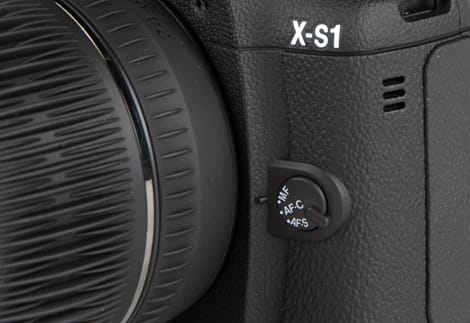
A dedicated focus-mode switch on the front panel.
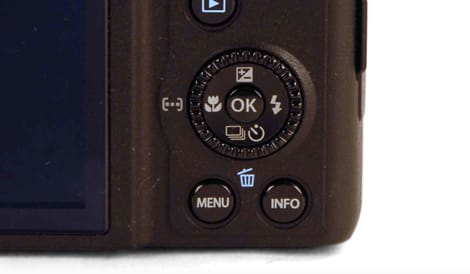
The scroll wheel surrounding the d-pad is neither awful nor perfect.
Drive/Burst Mode
{{section_header}}{{section.name}}{{/section_header}}
The fancy Exmor R sensor chip inside the TX5 camera gives it an edge: Sony claims it can capture a burst of 10 images at full resolution in around a second. We found it was a little slower than that (see below), but it is still a pretty speedy camera. There are also three options for burst mode; high, medium and low. The low speed captures about 2 frames a second, but is still limited to 10 shots. Unfortunately, there is no mode for continuously shooting images and saving them to the memory card, or a mode for shooting images at a preset interval. With all of these modes, you have to wait for some time for the camera to write the images out to the memory card; typically about 10 to 13 seconds.
Shot to Shot ({{product.raw_scores['Shot to Shot Score']}})
The TX5 is a speedy camera: we measured the fastest burst rate at 8.88 frames per second, a whisker below the 10 fps figure that Sony quotes. Some other point & shoot cameras can achieve similar speeds by reducing the resolution, but the TX7 still captures the full resolution 10 megapixel images at this speed, which is impressive.
Handling
{{section_header}}{{section.name}}{{/section_header}}
The TX7 is a small, thin camera that looks cool, but it is a little awkward to hold onto. There is nothing on the front of the camera for the fingertips to hold onto, and the smooth coating of the camera makes it slippery, especially with sweaty hands. There is a set of ridges on the back for the thumb to grip to, but these are rather small, and it is a little too easy for the thumb to sit on the screen, which means that the touch screen doesn't work as it is supposed to.




These dedicated buttons give you quick access to aperture and shutter speed controls.
Buttons & Dials
{{section_header}}{{section.name}}{{/section_header}}
There are just a handful of physical buttons on this camera: on the top are the power, shutter and zoom controls, plus buttons for playback mode and switching between still and movie modes. All of these buttons are rather small, and the zoom control is right on the corner of the camera body, so you have to move your finger to reach it, which contributes to it slipping from the grip.
All of the other controls on this camera are accessed through the touch screen interface, which has a few issues, such as occasional missed touches and slow response. The screen also ignores you if you touch the screen in more than one location, and that's easy to do if your thumb ends up resting on the top right of the screen by accident. Using the included paint pen (a small piece of plastic that fits onto the wrist strap) improves the situation slightly, but you shouldn't need to use that to hit a button on the screen.


Menus
{{section_header}}{{section.name}}{{/section_header}}
Because the TX5 relies on the touch screen for all of its operations, the on-screen menu is very important. We found that, once again, that using this was a mixed experience. The touch screen works well enough when you are pressing buttons on the screen (such as pressing the button to start capturing a movie), but it is kind of awkward when you have to scroll around to access a menu option; the scroll buttons are small and easy to miss. We also found that the touch screen didn't recognize some screen touches: we sometimes had to tap twice to select an option on menus, which was rather irritating.
If a user is uncomfortable with the menu, it might be worth putting the camera into easy mode, which offers simpler menus with larger text and fewer options.
Manual & Learning
{{section_header}}{{section.name}}{{/section_header}}
The TX5 comes with a handbook which covers the use of the camera in detail. This is generally well written and easy to use, but it does gloss over some of the details on how the features of this camera work. The Hand-held twilight mode, for instance, is described thus: 'Although night scenes tend to blur by camera shake, this mode allows you to shoot night scenes with less noise without using a tripod.' While that is true, it is not helpful in explaining what the mode does or how to get the best results out of it.
Panasonic Lumix DMC-ZS3 Comparison
The Sony DSC-TX5 and TX7 share a lot more than a similar name. Both use the same image sensor, lens and processing components. So, it is no surprise that the two are very similar performers, scoring highly across our range of tests. They also both offer similar special shooting features, such as the improved low light and motion processing, sweep panoramas and HDR shooting. The differences between the two are that the TX5 is slightly smaller and is tougher: it can handle 10 feet of water, being dropped and temperatures down to -14 Fahrenheit. The TX7 is a frail thing by comparison, throwing its hands up in horror at water, being dropped and low temperatures. The other major differences are the screen, with the TX5 having a much lower resolution screen that shows a much blockier picture and the dock: the TX5 doesn't have one.
So, if you are the type that likes to run, jump, fall, dive or otherwise endanger your life, the TX5 is the better pick. If you'd rather stay at home, take photos of the kids and show them off, the TX7 is the better pick because of the better screen and the dock that makes connecting it to a HDTV easier.
Samsung TL225 Comparison
Both of these cameras are small and compact, but the Sony DSC-TX5 is the smaller and sexier of the two, with a lens that is completely within the camera body (the ZS3s lens telescopes out of the body) and a sliding panel that protects the camera body. We found that both cameras had their strengths in our image quality tests, though; they scored similarly for color, but the Sony had much lower noise (especially at higher ISO settings) and produced sharper images. The ZS3 shot better video, though; the videos it captured were significantly sharper and had better color.
The ZS3 is not as tough as the TX5: it is not waterproofed or shockproofed. The ZS3 was released last year, so it is now available for a very decent price of $250, $100 less than the Sony. As such, it represents a good deal, but the TX5 might be a better deal if you can afford the extra and need a camera that can handle rough handling.
COMP 3
Both the Sony DSC-TX5 and the Samsung TL225 have big, bright screens on the back of the camera body, but the TL225 ups the ante by adding an additional 1.5-inch screen on the front of the camera for shooting self portraits and attracting the attention of kids. We found that the two cameras were quite similar in performance, with similar color accuracy and noise. We did find that the Anti-motion blur mode of the TX5 was significantly more effective than the optical image stabilization of the TL225, although it does take several seconds to process the image.
Conclusion
The Cyber-shot DSC-TX5 is a small camera that takes high quality images with good color and plenty of detail. We also found that the images that it captured had low noise and that the special shooting modes that the camera offers produced great looking results.
It's also a tough camera that can handle being immersed in up to 10 feet of water, can survive being dropped from 6 feet and temperatures of down to 14 degrees Fahrenheit (-10 degrees centigrade), which would make it a good shooter for snorkel diving or skiing.
The TX5 looks very similar to the Sony Cyber-shot DSC-TX7 and the two camera share the same sensor and lens system. But the TX5 is slightly cheaper, smaller and has a lower resolution screen, which makes the images look less attractive. We did find that the TX5 had the same slick looks, easy handling and genuinely useful special shooting modes. These make it a very attractive package for those who want a compact camera that can handle the rough and tumble of the outdoors and shoot good looking images at the same time.
Photo Gallery
{{photo_gallery "Front Photo", "Back Photo", "Sides Photo", "Top Photo", "Bottom Photo", "Lens Photo", "Flash Photo", "EVF Photo 1", "EVF Photo 2", "LCD Photo 1", "LCD Photo 2", "Media Photo", "Modes Photo", "Manual Controls Photo", "Manual Controls Photo 2", "Other Controls", "Buttons 1", "Buttons 2", "Other Hardware Photo", "Battery Photo", "Ports Photo 1", "Ports Photo 2", "Ports Photo 3", "Ports Photo 4", "Handling Photo 1", "Handling Photo 2", "Handling Photo 3", "Box Photo"}}
Meet the tester
Richard Baguley is a veteran writer who has written about technology ranging from Alphabet to Zip file utilities. He has contributed to pretty much every major tech publication, including Amiga Format Magazine, PC World, Wired, CNET, Toms Guide, Forbes, and many others. He lives in the Boston metro area with his wife, dog, and an indeterminate number of cats.
Checking our work.
Our team is here to help you buy the best stuff and love what you own. Our writers, editors, and experts obsess over the products we cover to make sure you're confident and satisfied. Have a different opinion about something we recommend? Email us and we'll compare notes.
Shoot us an email